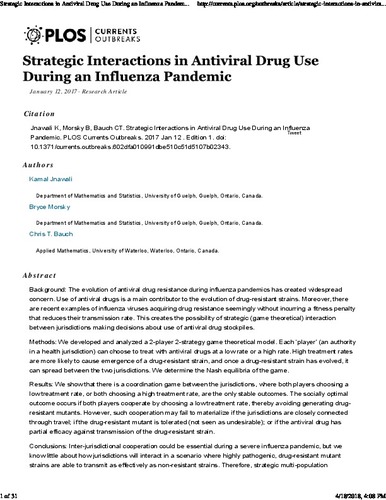| dc.contributor.author | Jnawali, Kamal | |
| dc.contributor.author | Morsky, Bryce | |
| dc.contributor.author | Bauch, Chris T. | |
| dc.date.accessioned | 2018-04-18 20:30:33 (GMT) | |
| dc.date.available | 2018-04-18 20:30:33 (GMT) | |
| dc.date.issued | 2017-01-12 | |
| dc.identifier.uri | http://dx.doi.org/10.1371/currents.outbreaks.602dfa010991dbe510c51d5107b02343 | |
| dc.identifier.uri | http://hdl.handle.net/10012/13118 | |
| dc.description.abstract | Background: The evolution of antiviral drug resistance during influenza pandemics has created widespread concern. Use of antiviral drugs is a main contributor to the evolution of drug-resistant strains. Moreover, there are recent examples of influenza viruses acquiring drug resistance seemingly without incurring a fitness penalty that reduces their transmission rate. This creates the possibility of strategic (game theoretical) interaction between jurisdictions making decisions about use of antiviral drug stockpiles. Methods: We developed and analyzed a 2-player 2-strategy game theoretical model. Each ‘player’ (an authority in a health jurisdiction) can choose to treat with antiviral drugs at a low rate or a high rate. High treatment rates are more likely to cause emergence of a drug-resistant strain, and once a drug-resistant strain has evolved, it can spread between the two jurisdictions. We determine the Nash equilibria of the game. Results: We show that there is a coordination game between the jurisdictions, where both players choosing a low treatment rate, or both choosing a high treatment rate, are the only stable outcomes. The socially optimal outcome occurs if both players cooperate by choosing a low treatment rate, thereby avoiding generating drug-resistant mutants. However, such cooperation may fail to materialize if the jurisdictions are closely connected through travel; if the drug-resistant mutant is tolerated (not seen as undesirable); or if the antiviral drug has partial efficacy against transmission of the drug-resistant strain. Conclusions: Inter-jurisdictional cooperation could be essential during a severe influenza pandemic, but we know little about how jurisdictions will interact in a scenario where highly pathogenic, drug-resistant mutant strains are able to transmit as effectively as non-resistant strains. Therefore, strategic multi-population interactions during influenza pandemics should be further studied. | en |
| dc.description.sponsorship | Canadian Institutes of Health Research | en |
| dc.language.iso | en | en |
| dc.publisher | Public Library of Science | en |
| dc.rights | Attribution 3.0 Unported | * |
| dc.rights.uri | https://creativecommons.org/licenses/by/3.0/ | * |
| dc.subject | antiviral drugs | en |
| dc.subject | antiviral stockpiles | en |
| dc.subject | drug resistance | en |
| dc.subject | fitness penalty | en |
| dc.subject | game theory | en |
| dc.subject | H1N1 | en |
| dc.subject | H7N9 | en |
| dc.subject | Influenza | en |
| dc.subject | influenza epidemiology | en |
| dc.subject | influenza model | en |
| dc.title | Strategic Interactions in Antiviral Drug Use During an Influenza Pandemic | en |
| dc.type | Article | en |
| dcterms.bibliographicCitation | Jnawali, K., Morsky, B., & Bauch, C. T. (2017). Strategic Interactions in Antiviral Drug Use During an Influenza Pandemic. PLoS Currents. https://doi.org/10.1371/currents.outbreaks.602dfa010991dbe510c51d5107b02343 | en |
| uws.contributor.affiliation1 | Faculty of Mathematics | en |
| uws.contributor.affiliation2 | Applied Mathematics | en |
| uws.typeOfResource | Text | en |
| uws.peerReviewStatus | Reviewed | en |
| uws.scholarLevel | Faculty | en |


